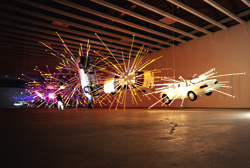Figurative sculptor and Gage Academy professor Michael Magrath has worked in bronze and other mediums for a number of years. (His latest, “Lot’s Tribe,” are three figures made of table salt, in Occidental Park.) Seattle Weekly art critic Sue Peters asked Magrath for his views on “fake” vs. “authentic” sculpture.
Seattle Weekly: Whatcom Museum in Bellingham is displaying some Rodin sculptures (and papers) from Stanford University’s Cantor Collection. A Florida gallery owner, Gary Arseneau, has declared the sculptures “fakes” because they were cast and signed posthumously, among other reasons. As a local artist who works in this “reproductive medium,” how do you explain to people the definition of “original” as it applies to your work?
Michael Magrath: “Fake” is a harsh word. I would prefer “unauthorized reproduction.” A fake would be a copy by another posing as the original. Though, this can get into gray areas.
“Original” in this media is a fugitive term. There really is no “original” in a bronze sculpture.You have a soft clay master pattern, a mold of some sort, a wax casting from that, a waste mold of that, and bronze castings, which often need to be welded back together, after that. Which of these is the original? It’s not like a painting or drawing where you either have the actual canvas scratched by the artist, or a repro.
What I consider the finished product is an artist-authorized cast. As sculpture can be a very time consuming and materially expensive process, the selling of a series of authorized casts is often the only way to recoup costs. Generally, it isn’t until the fourth or fifth cast in a series before an artist even breaks even.
What is your opinion of posthumous casts?
Posthumous casts are highly dubious for the reasons below, especially one that is “posthumously signed.” One gray area is the notion of a cast authorized by the artist’s estate. On one hand, it is perfectly legal, and even a subject of some empathy, especially for immediate survivors who often suffered with the artist through a long haul from destitution to solvency.
The case of Frederick Hart’s widow, who has recently been casting extensively off of previously “closed” editions, is very illustrative.
Art professor and Rodin specialist Albert Elsen drew up some guidelines in 1974 to address these issues. Is there still a problem with renegade unauthorized casts of sculptures? Have there been any famous cases of this happening?
I think Rodin’s are the most famous. I can’t think of any others off hand.
Are you of the mind-set that the only true “original” is the initial clay or wax model the artist uses to make his/her molds and sculptures? Or is that too purist?
“Original” to me does not actually mean the clay, unless that clay is to be fired and displayed as a finished work.
I take a more industrial approach. I look at the clay (or wax or other agglomeration of materials) more as a pattern from which a mold is taken. The clay is the master pattern from which molds and later casts can be made.
The mold is a tool which can be used to make an artwork either by the artist or an authorized representative. The resulting casts can either be authentic or complete frauds by degree.
The key is whether the work is authorized by the artist, and at what stage. The further the artist from each stage, the further the work is removed from authenticity. The actual hand of the artist on the final work is the closest to pure authorization, and would thus have the best pedigree. In cast media such as bronze, that means that at some stage the artist is actually welding, chasing, and otherwise finishing the cast. It means they have gone over it and made adjustments to their exact specifications.
The next level would be a cast where the work is done by another who is directly overseen by the artist. In this case, the artist proofs the cast and signs off on it. It can be assumed to be a true representation of the intent of the artist. Ironically, as often the fabricator is a more highly trained craftsman than the artist, this work can be both a bit less authentic and yet “better” than the master.
The next would be a worker, contracted by the artist, making and finishing the cast with no direct artist oversight. It goes to the gallery or customer without the artist ever actually seeing it. At this stage, assuming the artist can reasonably check the work against a master pattern, the work remains authentic, if of less artistic value. Think [of] hundreds and hundreds of Wyland dolphins in shops around the world.
One step even further removed and teetering on the cliff of authenticity is the artist-authorized, worker-realized work. A painter like Wyland contracting a ghost sculptor to create a clay master which is never actually seen or signed by the artist and then made into an edition and sold at a gallery as a Wyland. No one doubts that this is a practice of dubious artistic value. When an artist like Maya Lin sends plans to fabricators at the Henry, or Sol Lewitt simply sends cryptic instructions to curators and then arrives for the opening, authenticity is not so much questioned.
Once the artist is unable to check the work, I believe authenticity fails. This holds good for production studios working with unauthorized molds or pirated knock-offs. It also holds for cases where the artist is dead or otherwise unable to authorize the work.
The simple reason is that, though with dedication and serious workmanship, perfect fidelity to the master pattern can be achieved, this is less common than generally imagined. There can be many stages in casting, with lots of room for error. Each cast in a limited edition really is its own creature. It is quite common for a foundry man to simply get it wrong, and the resulting work to be an abomination. Therefore, I don’t think that any posthumous work, no matter how faithfully reproduced, should ever be represented as anything other than an approximation of the artist’s intent.
Wouldn’t the term “limited edition” attached to any multiple cast sculpture be more accurate than “original”?
Definitely, it’s the preferred term. Then the question is what number is the cast in the edition, and how many editions are there? There also comes a question of generations of a cast.
Just like any recording media, molds and casts degrade with each iteration. Molds rip and lose detail, and have a shelf life, with each cast and year degrading it by bits. Once the master pattern and molds are gone, molds are taken off of casts, creating a new generation. This next generation is markedly different than the master. The process of casting introduces size distortion (a bronze can be 8–10 percent smaller than the pattern) and the process of chasing [and] welding introduces marks and textures that were never on the pattern, never could have been made on clay. If one of these casts is later molded and made into a pattern, the degradation can attain the depths of kitsch.
Do you think that people in the art world generally believe that people like the Cantors are doing the public and the art world a service by disseminating posthumous casts, or are they diluting the integrity of those more “authentic” sculptures cast during Rodin’s lifetime?
“In theory,” [as] long as there is a clear line drawn between authorized and posthumous casts, the integrity of the first should not be damaged. Though in practice, with the water muddied as it is with casts of various generations about, that remains an unlikely event.
Do you think the general public is being deceived at all by these posthumous sculptures that Rodin never saw nor touched? Or is it simply a legitimate way for people who might not make it to the Musee Rodin to experience Rodin?
This is the point. As long as the work is not represented as being authentic, but rather a representation, then the public is not mis-served. I think the public is often intentionally deceived by galleries and show promoters who have an obvious interest in blurring this line, and should be called on it by the press. However, we remain better served by seeing even these knockoffs (which may have high fidelity to the master pattern) than not. My first Rodin, an acknowledged posthumous cast in Pittsburgh, nevertheless moved me very much, and inspired rather than discouraged my eventual trip to the Musee Rodin.








